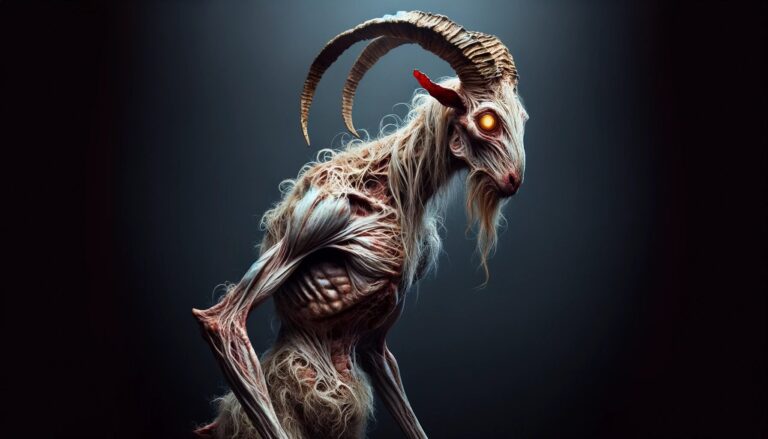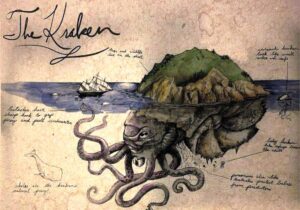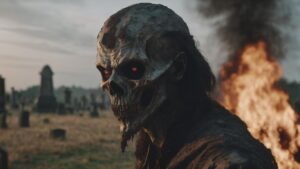Table of Contents
In the shadowy realm of American folklore, where tales of the bizarre and the unexplained often find their home, one creature stands as a particularly eerie and enigmatic enigma – the Pope Lick Monster. This mythical beast, shrouded in mystery, has captured the imaginations of countless individuals and has become a staple of urban legends and spooky campfire stories.
Origins and Family
The folklore of Louisville, Kentucky, deeply entwines the origins of the Pope Lick Monster. Furthermore, this region has long nurtured tales of strange and supernatural occurrences, and the Pope Lick Monster is no exception. People believe the monster inhabits the area around the Pope Lick Trestle, a railroad bridge spanning over Pope Lick Creek, which adds an eerie backdrop to the legend. In terms of its family, it is worth noting that people often portray the Pope Lick Monster as a solitary creature, which makes it an anomaly among cryptids. Typically, cryptids have familial ties in their legends.
Appearance
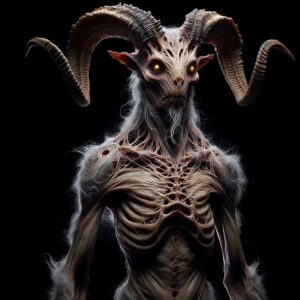
Goat-Like Lower Body: The most consistent aspect of the Pope Lick Monster’s appearance is its lower body, which people often depict as that of a goat. This includes having cloven hooves as its feet, similar to those of a goat. This goat-like lower body gives it a distinctive and unsettling appearance.
Humanoid Upper Body: The Pope Lick Monster’s upper body resembles that of a human above its goat-like lower body, albeit with a grotesque and distorted visage. This upper body includes arms and a torso that are humanoid in form, but descriptions often portray them as emaciated and twisted.
Matted, Stringy Hair: Reports of the creature’s appearance often mention that it has matted and stringy hair or fur covering its body. This unkempt and disheveled appearance adds to its overall eerie and unsettling image.
Glowing Eyes: People frequently describe the Pope Lick Monster as having glowing or luminescent eyes that pierce through the darkness and contribute to its eerie appearance. These descriptions often depict these glowing eyes as red or yellow, further intensifying the sense of malevolence.
Twisted Horns: Another distinctive feature of the creature is the presence of sharp, twisted horns on its head. People often describe these horns as curved or spiral-shaped, which adds to its overall sinister countenance.
Pale and Leathery Skin: Some accounts mention that the Pope Lick Monster has pale, leathery skin that gives it a ghastly appearance. This skin texture contrasts with the fur or hair on its body, creating a stark visual contrast.
Abilities
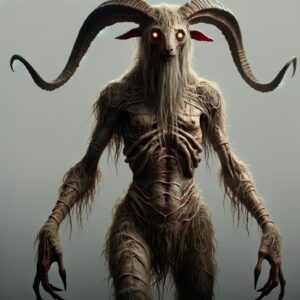
Voice Mimicry: One of the most notorious abilities of the Pope Lick Monster is its capacity to mimic human voices with uncanny accuracy. The creature is said to call out to individuals in distress, imitating the cries of their loved ones or even their own voices.
Luring and Deception: The Pope Lick Monster’s primary modus operandi involves luring victims to their doom. By using its voice mimicry abilities, it tricks people into venturing onto the dangerous train tracks of the trestle.
Trickery and Disorientation: The creature’s ability to mimic voices extends beyond just one individual; instead, it can create a cacophony of sounds and cries that can confuse and disorient its victims. This confusion makes it difficult for those on the trestle to discern the source of the voices, adding to their sense of helplessness.
Predatory Behavior: Once victims are drawn onto the train tracks, they are met with a gruesome fate – an oncoming train. The Pope Lick Monster’s ultimate goal is to lead individuals to their deaths by convincing them to stay on the trestle, even as the train approaches. The victims often realize too late that they are in a perilous situation and cannot escape in time.
Paralyzing Fear: The Pope Lick Monster’s mere presence is enough to strike fear into the hearts of those who encounter it. Its grotesque appearance, glowing eyes, and eerie abilities contribute to a sense of paralyzing fear, rendering its victims helpless in the face of danger.
Sensitivity to Holy Objects: Similar to many supernatural creatures in folklore, rumors suggest that the Pope Lick Monster is sensitive to religious symbols and holy objects.Carrying protective talismans, crosses, or invoking divine intervention may provide some defense against this malevolent entity.
Weaknesses
Despite its fearsome reputation, the Pope Lick Monster has vulnerabilities. The creature often calls the dark and treacherous trestle its home, which is fraught with danger. Trains still use the tracks, making it an incredibly perilous place for both humans and the monster itself. Additionally, like many other mythical beings, the Pope Lick Monster is said to be sensitive to religious symbols and holy objects. Carrying protective talismans or invoking divine intervention may offer some defense against this sinister creature.
Behavior with Humans
The Pope Lick Monster is not renowned for its benevolence or friendly interactions with humans. Its primary mode of interaction involves luring victims to their demise. However, it’s important to note that the legend itself is likely a cautionary tale to discourage people from venturing onto the dangerous train tracks of the trestle. Some accounts suggest that the monster may have been born out of tragic accidents that occurred on the trestle, with the legend serving as a grim reminder of the real dangers associated with the area.
Symbols Representing It
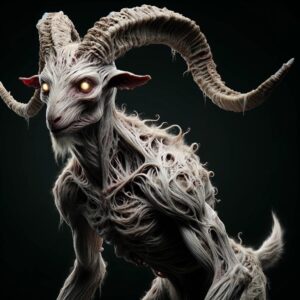
While the Pope Lick Monster does not have an extensive array of symbols associated with it, its terrifying visage and association with the Pope Lick Trestle have become iconic representations of the legend. People often use imagery of the creature’s grotesque appearance, combined with the foreboding silhouette of the trestle, to evoke a sense of dread and unease.
Related Myths and Stories
The Pope Lick Monster’s tale is not isolated; instead, it shares common elements with other cryptids and urban legends. Furthermore, the concept of a creature that lures victims to their doom is a recurring motif in folklore worldwide. In fact, it echoes elements of the sirens from Greek mythology and the kelpie from Scottish folklore. Both of these mythical beings use deceptive voices to draw unsuspecting individuals to their demise.
Other Creatures
The Jersey Devil: The Jersey Devil possesses a similar ability to mimic sounds and voices. It often appears with a combination of animal and humanoid features and has strong associations with the Pine Barrens of New Jersey.
The Kelpie: In Scottish folklore, the Kelpie, a water spirit, can assume the appearance of a horse, among other forms, to lure unsuspecting victims into the water.
The Wendigo: The Wendigo, originating from Algonquian mythology, terrifies with its appearance and its uncanny ability to mimic the voices of its victims, drawing them deeper into the wilderness.
The Skinwalker: Native American legends attribute the power to the Skinwalker, allowing it to assume the shape and voice of various animals or humans, often for malicious purposes.
The Banshee: In Irish folklore, the Banshee, a female spirit, gains renown for her eerie wailing or screaming, which is considered an omen of death.
The Chupacabra: While differing in appearance from the Pope Lick Monster, the Chupacabra earns its reputation for elusiveness and its capacity to inspire fear in people due to its strange and menacing features.
FAQ
What is the Pope Lick Monster?
The Pope Lick Monster is a legendary creature from American folklore, said to inhabit the area around the Pope Lick Trestle in Louisville, Kentucky.
What does it look like?
It is described as having a goat-like lower body with cloven hooves, a humanoid upper body with a grotesque appearance, matted and stringy hair, glowing eyes (often red or yellow), and twisted horns on its head.
What is Pope Lick Monsters reputation?
The Pope Lick Monster is known for being malevolent and is said to mimic voices to lure victims to their doom.
Are there any protective measures against Pope Lick Monster?
Some believe that carrying protective talismans or invoking divine intervention may offer defense against this sinister creature.
Is it connected to other cryptids?
While it shares some similarities with other cryptids in folklore, such as its ability to mimic voices, it is primarily associated with the Louisville area.
